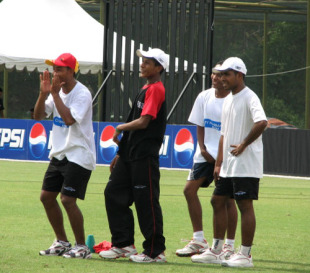A whole new experience for Papua New Guinea

| ||
The first day of matches in the Under-19 World Cup appear to be, on paper at least, a series of mismatches: Australia play Namibia in Penang, Malaysia face defending champions Pakistan in Johor, while England take on neighbours Ireland in Kuala Lumpur. The biggest mismatch, though, could be at the Kinrara Oval where India, who are expected to progress towards the final rounds, play the qualifiers from the East Asia Pacific region, Papua New Guinea.
The difference between the two teams, and countries, couldn't be starker. India are entertaining thoughts of a sizeable victory, keeping an eye on the net run-rate in a group which includes South Africa and West Indies; Papua New Guinea have lost each of their 18 matches in their four previous appearances in this tournament. Millions of children play cricket in India whereas only a few thousand play the game in Papua New Guinea, primarily because the facilities are minimal and the equipment too expensive.
The Papua New Guineans realise that hardly anybody is giving them a chance of upsetting India and the reality is that, apart from coping with the opposition, several of their cricketers will be facing additional problems, which are inconceivable for established teams like India.
The majority of the Papua New Guinea team have never played on a turf wicket, because there isn't a single turf facility in their country. Arua Dikana, Colin Amini, Lua Nou, Willie Gavera and Tony Ura and the only ones who've had some experience on turf and that was because they went to Australia as part of an East Asia Pacific squad. They don't have any academies in Port Moresby, the capital city and the main cricketing centre, either.
Vic Williams, who is an employee of Queensland Cricket and has been associated with developing the sport in Papua New Guinea for the last two years, believes that turf wickets will pose the greatest challenge. "There are no turf wicket facilities in Port Moresby," Williams said. "They play on concrete wickets with mats rolled out on the top."
The Papua New Guinea players appeared to be extremely fit and athletic during their practice session at the Kinrara Oval. They had a high-energy catching session and were enthusiastically cheering each other on at the nets. Williams said that the players were at their best when they were "laughing and having fun", but a huge problem area was sustaining the concentration levels and intensity for the duration of the 100 overs.
"They don't get tested for 50 overs in the club cricket that they play. The boys can play good cricket but in short patches. So they need to string those patches together and play good cricket over a long period of time."
Unlike India, who won both their warm-up matches against New Zealand and England, Papua New Guinea lost theirs to Ireland and Malaysia because of their inability to sustain their performance through the course of the match.
"Our first 16 overs in the field against Malaysia were exceptional," Williams said. "They were sliding, there were assists with flick throws, and two people were chasing every ball. But when we got to the drinks break, they fell apart and it went back to club stuff.
"It's about mental concentration and the ability to keep that [intensity and concentration] going over a long period of time. It's a big learning curve, to learn how to put together three sessions in the field and then three sessions with the bat. We should have won against Ireland. We were about 30-40 runs short with the bat because we lost our last six wickets for 12. Ireland got there with eight wickets down."
The problems with the Papua New Guinea batting are as simple as playing straight when the ball is directed at the stumps. "They're like the West Indians when they bat: they like to hit the ball and are a bit cavalier in their approach," Williams said. "Against Malaysia, the biggest downfall was the shot selection. About six guys were out playing across the line. It's a patience thing because they can get away with that in club cricket."
| "They're like the West Indians when they bat: they like to hit the ball and are a bit cavalier in their approach" | |||
Undoubtedly the problems are due to the lack of facilities at home. On concrete strips the bounce is true, so the players can hit across the line. They also get used to playing lofted shots simply because the grass on the outfields at Amini Park is often left uncut, which means batsmen don't get value for well-timed shots along the ground.
A big positive, though, is Papua New Guinea's bowling attack. In Willie Gavera, Loa Nou and Jacob Mado, a left-arm bowler, they have three strapping fast bowlers who hit the pitch hard at a sharp pace. Colin Amini, their captain, bowls offspin and has a doosra in his armoury.
"For them it's about learning how to wins games," Williams said. "They've got self belief but they have to get across the line." The odds of Papua New Guinea getting there against India might be negligible, but if they can begin strongly and sustain themselves for the majority of the game, they might just catch one off the tournament favourites by surprise.
George Binoy is a staff writer at Cricinfo

